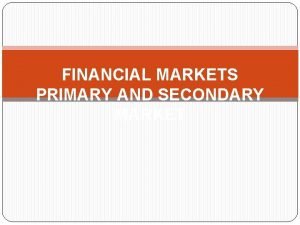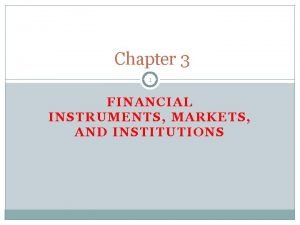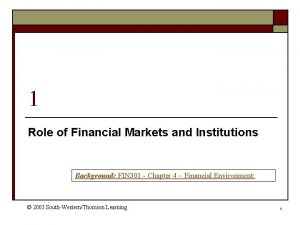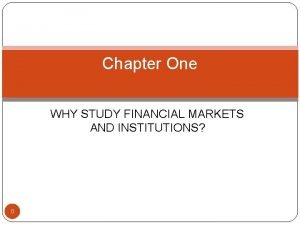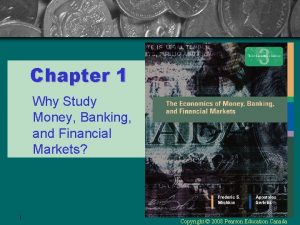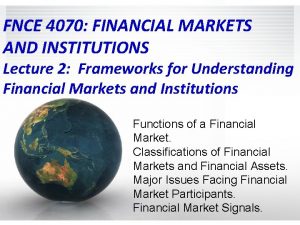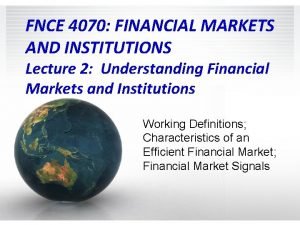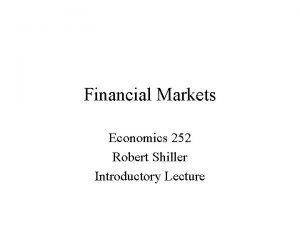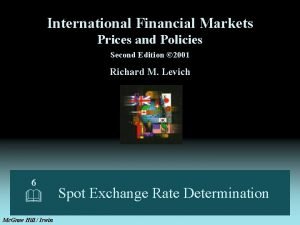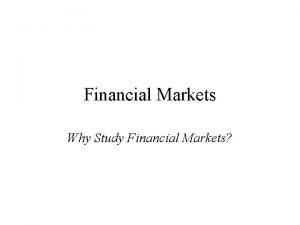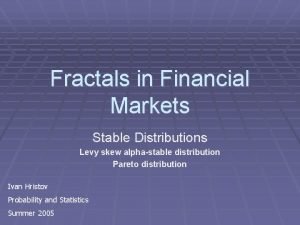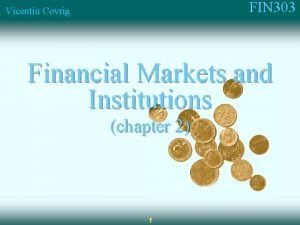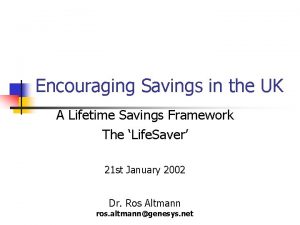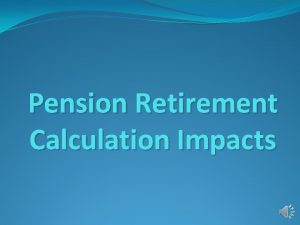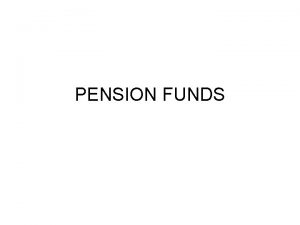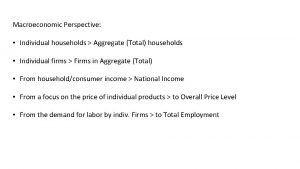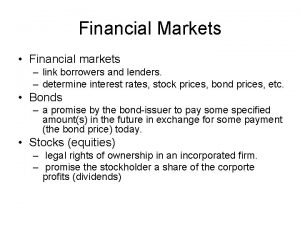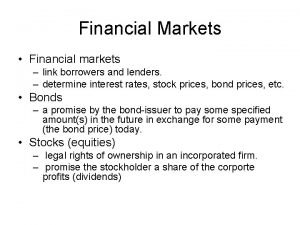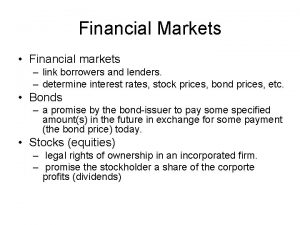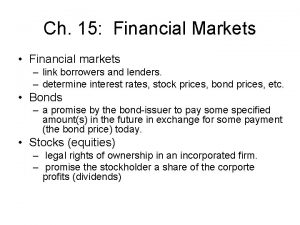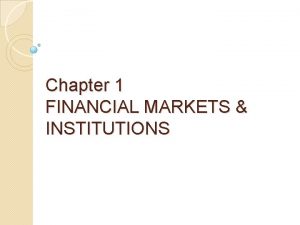Pension Reform and Financial Markets Encouraging Households Savings


































- Slides: 34

Pension Reform and Financial Markets: Encouraging Households Savings for Retirement Anita Tuladhar International Monetary Fund June 2007 Conference on International Forum on Pension Reform: Exploring the Link to Labor and Financial Market Reforms The views expressed herein are those of the author and should not be attributed to the IMF, its Executive Board, or its management.

Background l l l Rapidly ageing populations Unsustainable pension system and public finances in the long run Introduction of funded pensions system with mandatory private individual account and voluntary supplemental accounts, including in the region. – – – l 1998 (Hungary, Kazakhstan); 1999 (Poland); 2001 (Latvia); 2002 (Croatia, Estonia, Bulgaria); 2003 (Russia); 2005 (Macedonia, Slovakia); Shifting of responsibility for old-age income to households (by working more or higher financial savings)

Question: How to encourage household financial savings for retirement? Outline of this presentation: l Examination of household financial savings – l Factors affecting pension fund savings – – l in particular, pension savings in some emerging and mature markets Descriptive analysis using cross country data Empirical analysis using more detailed pension fund data from Latin America. Policy implications for pension fund regulations

Household balance sheets: Share of financial assets in total wealth varies considerably.

Household balance sheets: Share of liquid assets in financial assets significantly larger in emerging markets.

Household balance sheets (contd. ) The low share of pension fund savings also observed in the OECD.

Factors Affecting Pension Fund Assets: A Cross-Country Comparison

Pension fund assets in non-OECD countries remains relatively low.

Theoretical foundations on determinants of household savings Macroeconomic conditions Income Wealth Real Interest Rates Inflation Unemployment Financial Market Development Investment Opportunities Liquidity constraints Preferences Household savings 1. Level 2. Composition Alternative Income Sources Public pensions (features and financing) Public transfers Household size Demographics Dependency ratio

Per Capital Income: Pension fund savings are positively correlated with income levels.

Demographics: An older population or a faster pace of ageing Is not related to significantly higher pension fund savings

Alternative income sources: Public pension policy affects incentives to save in pension funds.

Alternative income sources: Generosity of public pensions likely reduces incentives to save in pension funds.

Pension Reforms: The maturity of the mandatory funded system is a significant determinant of the size of pension fund savings.

Financial market development: Pension fund savings shows a strong positive relation with financial market development. Direction of causality?

Financial market development: Pension fund savings are inversely related to financial market volatility. Market stability or preference for safer assets?

Financial market development: Pension fund savings are inversely related to risk adjusted returns in the equity market. Investment limitations or lack of deep liquid markets?

Empirical analysis l l Question: What factors enhance participation and pensions savings? Equations: 1. Change in pension fund participation = f (fund performance, years since reform, change in income, change in unemployment rate) 2. Change in pension fund assets per participant = f (fund performance, change contribution rate, change in income, rates of return on alternative investments) l Data: – – – l Pension fund data: FIAP on Latin American countries Macroeconomic data: WEO Financial Market data: IFS, World Development Indicators, Bloomberg Unbalanced Panel Data with 8 countries

Results: Equation 1

Results: Equation II

Key Factors and Challenges to Pension Fund Savings l Structural factors limit pension fund coverage – – l Pension savings on a voluntary basis low reflecting – – – l l high unemployment rate low income levels still generous public pension system level of financial sector development that limits investment opportunities or low financial awareness thereof, or myopia Improved performance on pension funds encourage savings Other variables: savings incentives, other income sources, demographic factors

Policy Implications l Enhancing coverage of pension income: – – creates a need for non-contributory social safety net for retirees (minimum public pensions or the zero pillar) make pension fund savings mandatory or require automatic enrollment as default option to improve participation l – In CEC’s generally, participation to funded pensions is designed as a carve-out of existing public pension contribution which is mandatory for younger workers. (~20 yrs for SVK, EST, MKD, HUN, ~30 yrs POL and LVA, ~40 yrs CRA, BLG, all for KZK) awareness/financial literacy

Policy Implications l Regulations for improving fund performance/net riskadjusted returns: – Investment in an optimum portfolio: l l – – regulations on asset allocation. For eg - shift from quantitative investment limits to prudent person rule or loosen tight regulations taking into consideration the development of local securities markets regulations on guarantees: For eg – minimum guaranteed return relative to industry Tax incentives on voluntary pension savings Minimizing fees and costs: regulations on fees, industry structure

Pension portfolios mostly in government bonds, reflecting both regulatory restrictions and lack of investment opportunities

Pension portfolios are shifting from bank deposits towards capital markets and international investments

Investment limits: Need to enable diversification, and also allow life-cycle investing

Policy Implications l Gradual easing of investment limits, especially on foreign investments – l Public debt management: – – l facilitates diversification gains especially in lack of domestic investments, limits foreign exchange market volatility Longer term instruments, inflation hedge, establishing liquid benchmark instruments, ensuring pension funds don’t become captive markets for government financing that provides cheap financing. Measures to strengthen capital market development – – Privatization, increasing available investment instruments, corporate governance regulations to improve supply Liquidity of these instruments also important

Minimum Return Guarantees (MRG): Significantly affects asset allocation and leads to herding behavior l Relative to the Pension Industry – l Relative to a benchmark – l Hungary No guarantees – l Kazakhstan, Poland, Croatia, Slovakia Bulgaria, Latvia, Estonia, Macedonia If MRG invoked, requires paying up from reserves, guarantee funds, etc.

Regulations on Guarantees: Flexibility in parameters of Minimum Return Guarantees, including setting of benchmark and portfolio choice

Other considerations: Tax incentives for voluntary savings not very effective for lower income and liquidity constrained individuals. l l No evidence of an increase in overall savings while mixed evidence of impact on composition of savings Effectiveness of tax incentives depend on the substitutability of different savings alternatives. Nonsubstitutability could arise from the motivation for – – l l (i) precautionary savings if liquidity constrained (ii) bequest to heirs Strong distributional effects with benefits accruing to older and richer individuals who face higher marginal tax rates. Fiscal costs

Industry structure: trending towards consolidation requiring a balance between competition in returns and scale economies to keep costs low

Minimizing fees and costs are important to ensure high net returns l l l High fixed costs has more distributional impact on lowincome savers. Centralization of basic services with scale economies such as account management, collections. This is already the case in most CECs. Minimizing costs from regulatory burden (for reserves, reporting, etc) and initial marketing costs. Regulatory ceilings for fees on contributions/assets which decline over time as asset size grows. Balance the costs with high concentration in the industry.

Financial Awareness l l l Financial education and awareness particularly if given choice of portfolio Greater need if low-income savers Dynamic default portfolio for passive investors Public information including availability of simulation models to analyze potential net replacement rates at retirement Easy access to account information Transparency and Accountability of pension funds – Publication of investment results and financial statements

Conclusions l l Share of pension savings in household balance sheets are relatively small but growing rapidly. Factors affecting pension fund savings – – – l Pension reform, mandatory savings, fund performance, Macro/Structural factors Financial sector development Policy implications for pension fund regulations – – Enhancing coverage through mandatory forms of savings, default rules and other social safety nets Enhancing net risk-adjusted returns through increasing flexibility for diversification gains, Reducing costs by harnessing economies of scale and minimizing other burdens Investor protection through information and education
 Commuted pension vs uncommuted pension
Commuted pension vs uncommuted pension Why study financial markets?
Why study financial markets? Financial markets and institutions jeff madura ppt
Financial markets and institutions jeff madura ppt Financial markets and institutions - ppt
Financial markets and institutions - ppt The financial system
The financial system International financial markets and instruments
International financial markets and instruments Capital markets and financial intermediation
Capital markets and financial intermediation Difference between primary and secondary market
Difference between primary and secondary market Financial markets and the allocation of capital
Financial markets and the allocation of capital Foreign exchange and international financial markets
Foreign exchange and international financial markets Basic flow of funds through the financial system
Basic flow of funds through the financial system Madura j. financial markets and institutions
Madura j. financial markets and institutions Pilbeam k. finance and financial markets
Pilbeam k. finance and financial markets Finance and financial markets keith pilbeam
Finance and financial markets keith pilbeam Primary vs secondary financial markets
Primary vs secondary financial markets Madura j. financial markets and institutions
Madura j. financial markets and institutions Why study financial markets and institutions
Why study financial markets and institutions Chapter 6 consumers savers and investors answer key
Chapter 6 consumers savers and investors answer key Why study money banking and financial markets
Why study money banking and financial markets Why study money banking and financial markets
Why study money banking and financial markets Classification of financial markets
Classification of financial markets Classification of financial markets
Classification of financial markets Shiller financial markets
Shiller financial markets Classification of financial markets
Classification of financial markets Classification of financial markets
Classification of financial markets Are financial markets efficient
Are financial markets efficient Levich international financial markets
Levich international financial markets International financial markets levich
International financial markets levich Cisi chartered wealth manager
Cisi chartered wealth manager Classification of financial markets
Classification of financial markets Fractals in financial markets
Fractals in financial markets Well functioning financial markets
Well functioning financial markets Why study financial markets
Why study financial markets Tithe in new testament
Tithe in new testament Paradox in romeo and juliet
Paradox in romeo and juliet







